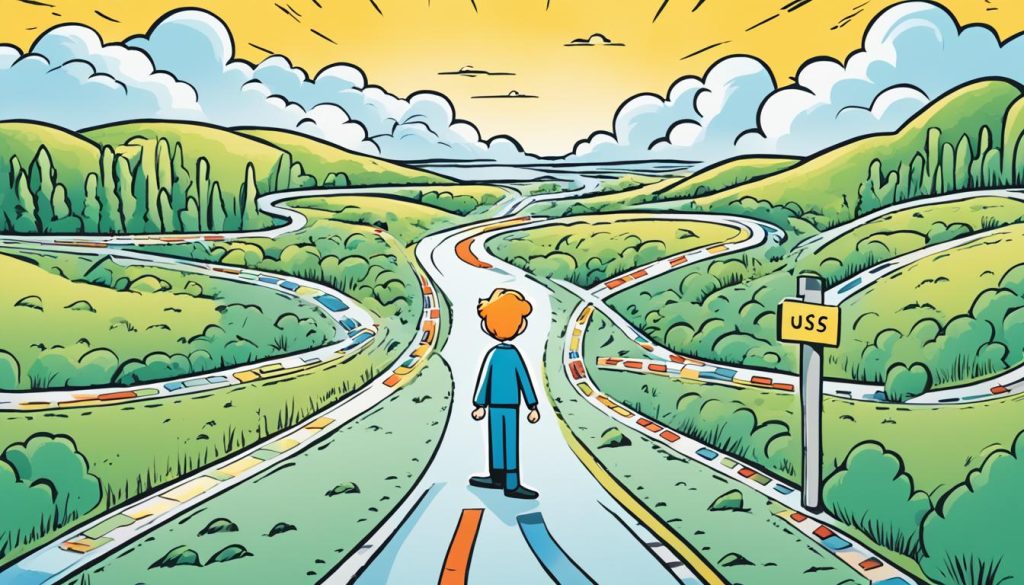Investing in futures can be a key part of your investment plan. Since the mid-19th century, futures contracts have let farmers sell wheat for future delivery1. Now, the market includes many securities, financial tools, and commodities2. Futures trading lets investors quickly and cheaply get into global markets. They can bet on or protect against the price changes of assets they trade. This is done by buying a futures contract. It’s a legal deal to buy or sell an asset at a set price on a future date.
Key Takeaways
- Futures contracts have been a key part of investing for over a century, now covering many asset types.
- Futures trading gives investors a quick and affordable way to tap into global markets. It helps with betting or protecting against price changes.
- Futures contracts are leveraged, meaning investors can control big positions with a small amount of money.
- Futures markets are open almost all the time, six days a week. This gives traders constant trading and protection options.
- It’s important to know the specifics and features of futures contracts to make good trading plans.
Understanding Futures Trading
Futures contracts let buyers and sellers agree on a price for an asset later3. They are key for both making bets and protecting against market changes3.
What are Futures Contracts?
A futures contract is an agreement to buy or sell an asset like a stock or currency at a set price later4. They are standardized, unlike forward contracts which can be customized4.
Key Futures Markets
Futures contracts cover many assets, like stock indexes and currencies4. The Commodity Futures Trading Commission (CFTC) oversees these markets in the U.S., ensuring they are fair4.
There are two main types of futures market players: hedgers and speculators5. Hedgers use futures to protect against price changes in their assets. Speculators try to make money from these changes5.
| Futures Market | Example Contracts |
|---|---|
| Stock Indexes | S&P 500, Nasdaq-100, Dow Jones Industrial Average |
| Energy | Crude Oil, Natural Gas, Heating Oil, Gasoline |
| Currencies | U.S. Dollar, Euro, Japanese Yen, British Pound |
| Cryptocurrencies | Bitcoin, Ethereum |
| Interest Rates | U.S. Treasury Bonds, Eurodollar |
| Grains | Corn, Wheat, Soybeans, Rice |
| Forestry | Lumber, Pulp |
| Livestock | Cattle, Hogs, Feeder Cattle |
Futures trading has big benefits, like using small money to control a large position3. Markets are open all the time, letting traders act fast on news from around the world3.
“Futures trading is a strategic tool that can be used to manage risk, speculate on price movements, and potentially enhance portfolio returns. However, it is essential to understand the risks and regulations governing these markets before engaging in futures trading.”
The Advantages and Disadvantages of futures
Advantages of Futures Trading
Futures trading has many benefits for investors. One big plus is leverage, which lets traders manage a big position with a small amount of money6. This can lead to bigger profits, but it also means bigger risks7. Futures offer a wide range of assets to invest in, helping to spread out risk6. They also work almost all day, giving traders chances to make money outside normal market hours7. Futures can also be used to protect investments from losing value due to price drops6.
But, futures trading has its downsides too. It can be hard for beginners because of its complexity and the need to keep track of contract end dates8. Taking on too much risk is another issue, as losses can grow quickly7. Some futures contracts might even require the trader to take physical delivery of the asset, adding more to think about6.
| Advantages | Disadvantages |
|---|---|
|
|

Investors need to think about the pros and cons of futures trading to see if it fits their goals and how much risk they can handle678.
“Futures trading is a dynamic and complex market that requires a deep understanding of the underlying mechanics and risks involved. Careful research and planning are essential for success in this arena.”
Selecting a Futures Trading Platform
When picking a futures trading platform, it’s key to look for features that make trading better and help manage risks. The best platform should be easy to use, offer many order types, and have good fees and commissions9.
For traders who like algorithmic trading, having API access is a big plus. Also, a mobile trading app for making trades and managing positions on the go is very useful9.
Choosing the right platform means thinking about what different traders need, as per RJO Futures Brokers:10
| New Traders | Experienced Traders | Professional Traders | Day Traders | Commercial Hedgers |
|---|---|---|---|---|
|
|
|
|
|
When looking at futures trading platforms, think about what you need based on your trading style and experience10. Trying out different platforms can help you find the one that fits your futures trading goals and risk management plans11.
Developing a Futures Trading Plan
Creating a detailed futures trading plan is key to doing well in this fast-paced market. It should clearly state your entry and exit strategies and risk management rules. Learning about evidence in criminal trials can teach you how important a solid plan is in futures trading.
Contract Specifications
Before trading futures, know the contract details like size, value, and tick size. These help you figure out the right position size and manage your risk well12. Futures contracts usually need an initial margin of 50% to 75% of the total value12. It’s crucial to have a solid risk management plan, focusing on position sizing to limit losses and aim for gains12. Your risk tolerance can be low, medium, or high, affecting how much of your portfolio you risk12. Knowing about tick size and value is key for understanding potential profits or losses.
Types of Futures Trading Plans
There are three main futures trading plans to consider:
- Long: Buy futures to make money from rising prices.
- Short: Sell futures to make money from falling prices.
- Spread: Buy and sell different futures contracts to profit from their price difference.
Choosing a plan means having a clear entry and exit strategy based on market analysis12. Figuring out the right position size is important, by dividing your maximum risk by the trade risk12. Entry strategies help spot good market conditions to buy at a target price12. Exit strategies are key for deciding when to close a trade to profit or cut losses.

With a well-planned futures trading plan, you can trade with confidence, manage your risk well, and increase your chances of long-term success13. Stop orders can limit your risk to $2 per ounce while aiming for a profit of $5 per ounce13. E-mini futures are smaller than regular contracts, making them easier to trade13. Micro E-mini contracts are even smaller, offering a chance to trade with smaller investments13. Futures trading requires a margin, not a loan, and is not for every investor.
Conclusion
Futures trading can be a key part of your investment plan. It offers chances for hedging, speculative investments, and making your portfolio more diverse14. By learning about futures contracts, the different markets and products, and the pros and cons, you can see if it fits your investment goals and how much risk you can handle14.
Creating a detailed plan for futures trading and picking the right trading platform are key steps. This helps you use futures trading well in your investment strategy14. The conclusions should sum up your research question, highlight main achievements, and end with a strong statement14. The future work section is good for talking about what’s next and possible collaborations14.
The academic world is facing a crisis, with many articles behind paywalls15. There’s a big need for research that solves real-world issues15. By focusing on research that makes a difference and using new ways to share it clearly and online15, academics can make their work more useful and easy to reach for people outside of school15.
FAQ
What are Futures Contracts?
Futures contracts let a buyer and seller agree on an asset price for future delivery. Most investors use them to bet on price changes or protect their investments.
What are the key Futures Markets?
Major futures markets include stock indexes, energy, currencies, and more. These are traded on exchanges like the Chicago Board of Trade and the Chicago Mercantile Exchange (CME).
What are the Advantages of Futures Trading?
Futures trading has many benefits. It offers leverage, diversification, and the chance to trade after regular market hours. It also helps investors hedge against losses.
What are the Disadvantages of Futures Trading?
Futures trading has its downsides too. It can be complex and risky if not managed well. Traders must also deal with contract expirations and the risk of physical delivery.
What should I look for in a Futures Trading Platform?
Choose a trading platform that’s easy to use and offers various order types. It should also have low fees and support for algorithmic trading. A mobile app for on-the-go trading is a plus for active traders.
What are the key components of a Futures Trading Plan?
A good trading plan is key to success. It should detail how to enter and exit trades, and how to manage risks. Traders use technical or fundamental analysis for signals.
There are three main trading plans: long, short, and spread. Understanding contract details like size and value is also crucial for managing risks.

